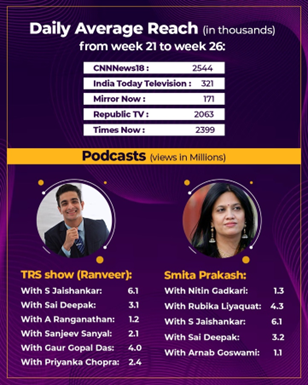Like all consumers, video viewers are continuously evolving in their media consumption habits. In recent times, there has been a noticeable shift in English-speaking audiences’ preferences, as they move away from leading news anchors with millions of followers. The once-popular faces of news broadcasting have experienced a decline in viewership over time. In their place, a new wave of content creators is gaining traction, particularly in the realm of podcasts. Figures indicate that individuals like Smita Prakash and Ranveer Allahbadia are becoming the go-to sources for news and information.
Initially, the news genre witnessed a surge in viewership during the early COVID-led lockdowns, growing its share in the total TV viewership pie from 7% to 21%. However, this momentum was short-lived, as news broadcasters struggled to sustain and capitalize on the additional share they had gained. According to data shared by a broadcaster, during the week 40-43 of 2022, the news genre’s share among the audience aged 15 years and above stood at 6.6% of the total TV viewership. Notably, there was a time when this figure was even lower, hovering around 4-5%. The news genre’s inability to maintain its initial growth raises questions about its long-term appeal to the audience in a rapidly changing media landscape.
Quantifying these shifts is not a straightforward task, as metrics and scales vary across platforms. However, by comparing views on YouTube and the daily average reach of news channels, some insights can be gleaned. It’s essential to note that the viewership numbers for these anchors are just a subset of the overall channel figures.
A closer look at the data reveals the following:

The data suggests a clear trend – viewers are gradually disenchanted with the traditional news formats characterized by six to eight people passionately debating on screen. Sensationalism, which was once a hallmark of news broadcasting, seems to have lost its charm. Instead, audiences are seeking more insightful and in-depth content, a departure from the sensationalized reporting they were accustomed to in the past.
Notably, the advertising rates for the news genre have reached a point of stagnation. While some prominent channels have asserted recent spot rate increases, the average cost of a 10-second spot on popular news channels still falls within the range of ₹2,000 to ₹5,000.
A senior executive representing a major fast-moving consumer goods (FMCG) company disclosed that they have scaled back their advertising presence on news channels, even though television remains their primary choice for media spending, especially for their food brands. The primary reason behind this budgetary decision for the news genre is linked to the perceived poor quality of content offered by these channels.
The podcasts, on the other hand provides a more refined and authentic avenue for news consumption, setting them apart from traditional TV news channels, along with the ability to understand the newsmaker on a more personal level. Unlike traditional news shows, podcasts offer a human side of the newsmaker, enabling the audience to connect with them on a deeper level. This shift indicates that viewers want to hear the newsmaker’s take on issues and gain a more comprehensive understanding of the topics at hand.
Lately, we’ve noticed a few podcasts partnering with brands as sponsors, but the progress appears to be quite sluggish. The presence of brands on YouTube podcasts and other platforms is notably limited. Is it high time for brands and agencies to wake up to the potential of podcast sponsorship?
Emerging trends indicate a clear embrace of the podcast medium by audiences. With its capacity to offer meaningful insights and a personalized experience, podcasts are captivating news consumers and revolutionizing the way news and information are consumed in today’s rapidly changing media landscape. While audiences are clearly embracing podcasts, the question arises: are brands following suit?


Recent Comments